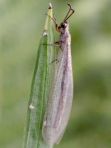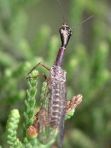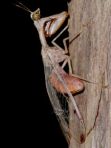
| Neuroptera ~ Lacewings, Antlions, Etc. |
|
This is a diverse group of insects, some of which are sometimes placed in separate orders or grouped together, depending on the authority cited. They are sometimes hard to identify as they could be confused with more familiar groups, such as damselflies or moths.
Adults and larvae of this order are carnivorous and are valued in pest control. Both stages have chewing mouthparts, sometimes forming very large mandibles, especially the larvae. Some mantisfly larvae feed on spiders or their eggs. The adults feed on insects, nectar and pollen. The name "neuroptera" refers to the net-like pattern of the wings. Most members of this group have four large, clear wings of about equal size. They are not particularly strong fliers. Neuropterans develop through complete metamorphosis: the active hunting larvae eventually form pupae, then emerge as winged adults. Larvae are generally more terrestrial than adults. Size ranges from very small to relatively large. Some may reach a length of about 25 mm. There are relatively few species in this order and they are usually easy to recognize to at least the family level. In cases where we have only one species per family, the whole identification process is delightfully simple.
|
 Chrysopidae [green lacewings] |
 Hemerobiidae [brown lacewings] |
 Berothidae [beaded lacewings] |
 Myrmeleontidae [antlions] |
||
 Ascalaphidae [owlflies] |
 Raphidiidae [snakeflies] |
 Mantispidae [mantisflies] |
 Coniopterygidae [dustywings] |
![]()